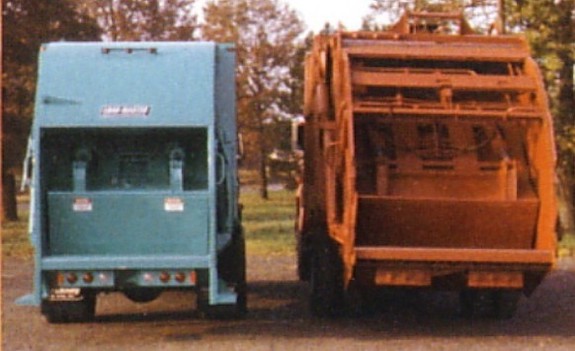 
LM-300 and LM-200 Series

Shortly after introducing the LM-100, City Tank Corporation unveiled a smaller version of the Load-Master designated the LM-300. The exact start of production is not currently known, but examples were on the streets by late 1967. The new model used the same packing method as its bigger brother, but with a much smaller 1.5 cubic yard hopper. The compact LM-300 was initially available in 13, 16, 18 and 20 cubic yard capacities. Concurrently, the 16 cubic yard version of the LM-100 body was discontinued.
COMPARISON: THE LM-300 VERSUS LM-100
The new LM-300 not only had a smaller hopper, but was of a much more compact proportions overall. As can be seen in the illustration below, the tailgate structure is shorter, with far less overhang beyond the rear axle than the bigger LM-100. Consequently, the LM-300 required a shorter packing cylinder (31" stroke), and the roller trucks had a more vertical inclination than the LM-100. The overall height of the 300's body was significantly lower at 85", versus 97" for the LM-100.

PACKING PANEL ASSEMBLES
The slide and sweep panels used in the LM-300 series were functionally identical to those of the original LM-100. The sweep panel differs slightly in shape and proportion because of the differences in tailgate shape between the two models.

|
The LM-300 series was available with same compliment of optional container hoists as the LM-100. Despite their differences, the two models shared a wide variety of internal hydraulic and mechanical components. City Tank's new model perfectly complimented the larger LM-100, targeting smaller municipalities and private contractors using the Leach Standard Packmaster, Gar Wood LP-700 and Heil Mark III packers. The introduction of the LM-300 may also have been a pre-emptive move to replace the Roto-Pac, which was becoming obsolete as the dawn of the 1970s approached.

An 18 cubic yard model LM-318

New York Mayor John Lindsay inspects the first shipment of Load-Master LM-320 refuse trucks delivered to the Department of Sanitation in early 1968. During the next two years, the DSNY took delivery of 400 of the new LM-320 packers on GMC chassis. Another 400 Internationals with Heil Mark III's were also acquired at that time. It was the beginning of the end for the Department's fleet of Roto-Pacs, which had been their front line packer since the early 1950s. Unlike the chain-conveyor Roto-Pac, the powerful Load-Master could handle regular refuse collection and bulk items on the same route. Better still, it hauled away seven tons average in its twenty yard body, compared to the roughly three ton payload of the old Roto-Pac.
|

City of Miami Load-Master LM-320 with USS Roll-a-Waste cart lift, and rare hopper door (1973

The small LM-316 was a powerful alternative to the Leach Standard Packmaster for smaller contractors

1970 model LM-318 in working condition, rescued by Bob Dutra in 2011
MODEL LM-200 (NARROW BODY)

To round out the Load-Master line, the narrow body LM-200 series was created for alleys and tight quarters often found in older cities. It was almost identical to the LM-300, except for its overall width of 84" and a slightly diminished hopper capacity as a result of the reduced width. It could be had with either 13 or 15 cubic yard capacity, with the former replacing the 13 yard version of the LM-300. It may be considered the successor to the Roto-Pac Alley Cats that were developed in conjunction with the City of Philadelphia in 1952.
By the late 1960s, Load-Master had a diverse line of rear loaders that were able to meet almost any hauler's needs, from the brawny LM-125, right down to the little LM-213 Alley Cat. City Tank was now well prepared for the termination of the primitive Roto-Pac line, which quietly faded away in the early 1970s. The Load-Master project born at the beginning of the decade had quite probably saved City Tank from extinction at the end of the decade. Indeed, they had a truly worthy product in Load-Master, which had an appeal far beyond that of the Roto-Pac. Its timing could not have been better, having come to the game just as the demand for more powerful rear loaders was growing.



7/4/10 (updated 12/08/24)
© 2010
All Rights Reserved
Photos from factory brochures/advertisements except as noted
Logos shown are the trademarks of respective manufacturers
|
|